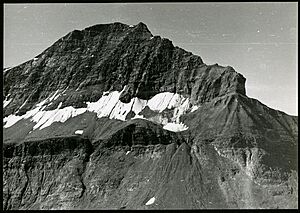Park Mountain facts for kids
Quick facts for kids Park Mountain |
|
|---|---|

Park Mountain and Lake McArthur
|
|
| Highest point | |
| Elevation | 2,951 m (9,682 ft) |
| Prominence | 338 m (1,109 ft) |
| Parent peak | Mount Biddle (3320 m) |
| Listing | Mountains of British Columbia |
| Geography | |
| Location | British Columbia, Canada |
| Parent range | Bow Range Canadian Rockies |
| Topo map | NTS 82N/08 Lake Louise |
| Geology | |
| Age of rock | Cambrian |
| Type of rock | sedimentary rock |
| Climbing | |
| First ascent | 1904 Survey Party |
| Easiest route | Scrambling class 3 |
Park Mountain is a tall mountain in Yoho National Park, British Columbia, Canada. It stands 2,951 meters (about 9,682 feet) high. You can find it near the beautiful Lake McArthur. Park Mountain is part of the Bow Range in the amazing Canadian Rockies. The closest taller mountain is Mount Biddle, which is about 3 kilometers (1.9 miles) to the east. This mountain is also not far from the Continental Divide, which is like a big line that separates rivers flowing to different oceans.
How Park Mountain Got Its Name
Park Mountain got its name in 1915. It was named because the area around it looked like a beautiful park. The Lake O'Hara area, where the mountain is located, is known as a very special place within the Canadian Rockies.
The first time someone officially climbed to the top of Park Mountain was in 1904. This climb was made by a group of people doing a survey of the land.
The mountain's name became official in 1952. This happened when the Geographical Names Board of Canada approved it. This board is in charge of making sure place names are correct and official in Canada.
What is Park Mountain Made Of?
Park Mountain is made of sedimentary rock. This type of rock forms from layers of sand, mud, and tiny bits of sea creatures that settle over millions of years. These layers were laid down a very long time ago, during periods known as the Precambrian and Jurassic eras.
Long ago, these rocks were formed in shallow seas. Later, during a time called the Laramide orogeny, huge forces pushed these rock layers up. This movement caused the rocks to fold and stack, creating the mountains we see today.
What's the Weather Like at Park Mountain?
Park Mountain has a subarctic climate. This means it has very cold and snowy winters. The summers are usually mild, not too hot. Temperatures can drop below -20 °C (which is -4 °F). With the wind, it can feel even colder, sometimes below -30 °C (-22 °F).
The snow and rain that fall on Park Mountain eventually melt and flow into rivers. This water first goes into smaller streams that feed into the Kicking Horse River. The Kicking Horse River then flows into the larger Columbia River.




